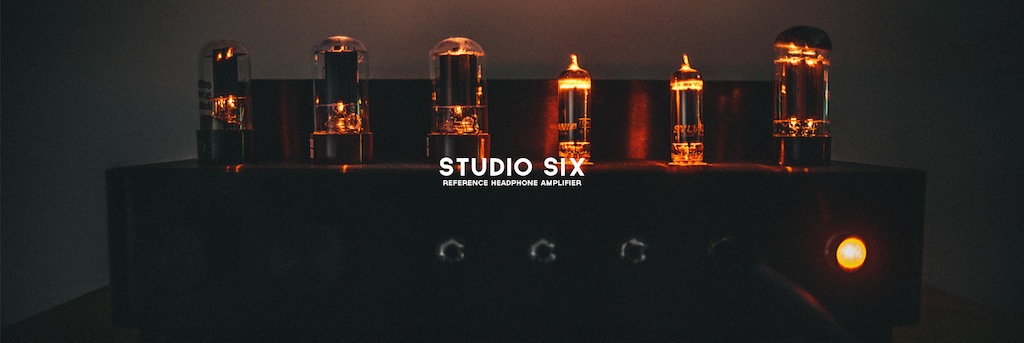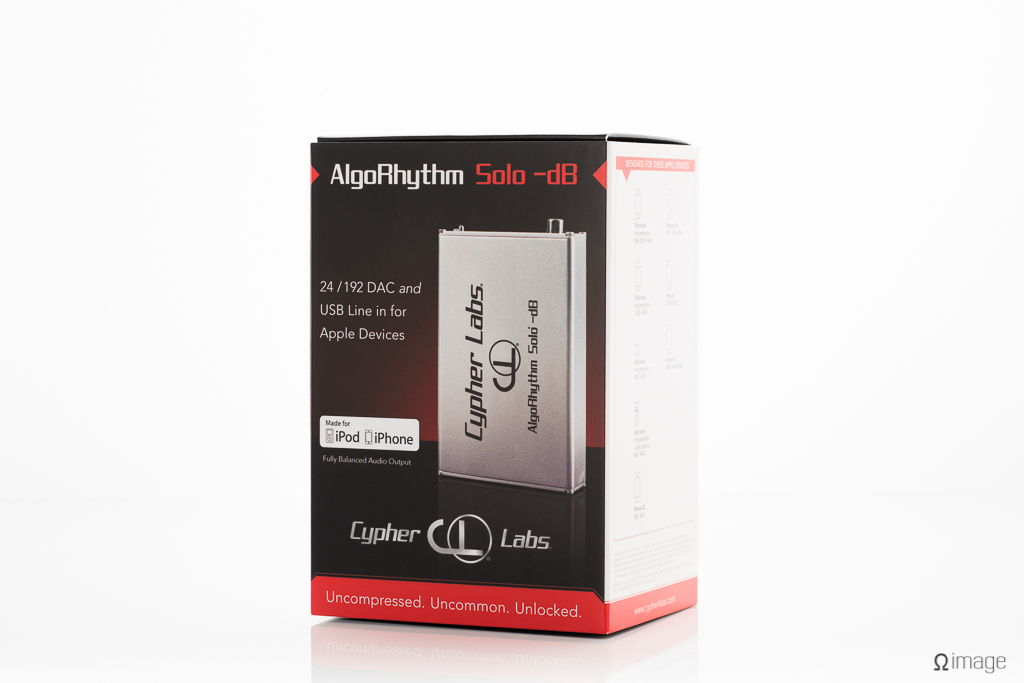Cypher Labs kicked portable audiophilia’s tail over a year ago with the original CLAS. With Cypher Labs’ DAC plugged into its arse the iDevice became a reference-level source. The same old story plays out now with the -dB, but this time, desktop audio, too, gets classy.
Spec:
DAC: AKM AK4396VF
• Dual source input from either computers or Apple devices and input detection is automatic
• USB audio resolution up to 16/48 from Apple devices
• USB audio resolution on Mac (natively) or PC (with included driver) up to 24/192
• Larger capacity battery delivers long play time, up to 14 hours and charges Apple devices
• Fully balanced analog line-level output (4 pin)
• Single ended line-level analog output
• Digital S/PDIF output
• USB mini-A input allows input from computers (USB A to USB mini-B) or Apple devices (use our 30 pin to USB mini-a cable)
• Package Contents:
- Cypher Labs AlgoRhythm Solo® -dB & User Guide
- Low profile USB-mini-A sync cable with right angle connectors
- USB A to USB mini-B cable (for computer)
- Cypher Labs straps to bundle devices for travel
- Switching 100v / 220v gloss black AC charger with heavy duty red cord and right angle barrel plug
- Embossed leather pad to protect devices when bundled
- Small USB female A to USB male mini-A adapter. Use with any standard 30 pin to USB A or Lightning to USB A sync cable
Cypher Labs AlgoRyhthm Solo DB: ~699$ USD
ohmage: DAC functionality
Part of kicking arse is having your bits arranged cleanly. The original CLAS turned iDevice bits into music. CLAS -dB works with computers, too. It’s plug-and-play friendly for both Mac and Windows. And, it’s seamless.
Rather than utilising discreet ports: one for iDevice, and one for PC, CLAS DB uniforms the process in a single mini-USB connection. The only downside to this is that finding proper lightning/30-pin cables for new iDevices can be a protracted torture. My iPhone 5 makes do with the included USB-A to mini step-down adapter. It’s ugly and fiddly. Mr. Maudlin assures me new cables are in the works.
I’ll queue.
Alternatively, you can hit up Forza Audio Works and come away with the most beautiful USB cable this side of the Milky Way.
DB’s software has been branded for both PC’s and iDevices. No Wuing through ridiculous Speaker, SPDIF, etc., options.
Cypher Labs went with coaxial output rather than optical toslink. Debates rage wildly from one corner of the internet to another, but well thought-out studies tend to agree: digital jitter is more evident over toslink than coaxial.
CLAS -dB utilises the common RCA jack to terminate the coaxial connection. RCA coaxial jacks tend to be robust, easy to find, and excepting a few rather inexpensive options out there, pretty much ubiquitous.
Analogue output is handled via a 3,5mm stereo phono jack. Considering -dB’s dual portable/desktop nature, 3,5mm works. Well-implemented RCA analogue connections can yield better channel separation, but would bugger this unit’s portability.
ohmage: haptics on the go
The current CLAS is bigger and beefier than its predecessor. Its sole input, a mini USB port, sits at the front. Headphone and line outputs cling to the back. The 9V mains socket is sunk into the front panel. The power switch sits at the back.
For out and about use, this layout is ergonomically sound when used with most portable amplifiers. And that is of prime importance. Because it doesn’t sport a headphone amplifier, CLAS must play nice with outboard equipment. Size-wise, it apes the ALO Rx MKIII almost romantically. They share similar aluminium cases and come in the same choice of silver or black. Their ins and outs are arrayed for harmonious use.
Recommending the Rx MKIII to go with a CLAS is a no-brainer. -dB’s performance is truly excellent. It should be matched with something just as good.
NOTE: Since -dB requires an outboard amp, your portable kit must needs get tubby. If you can handle that, my recommendations come attached.
porridge: haptics on the desk
Where portably the CLAS gets on like a house on fire, for desktop and home HiFi use, it sort of gets the hose. Cables fire off in every direction. Being light, -dB might not even sit flat. If you value a clean-looking desktop audio system, you will have to hide your CLAS and its profusion of cables in a drawer. If you don’t have the luxury of a drawer, there’s always tape and the back of the desk. Or the floor. Or a strategic box of tissue with holes cut for the occasion.
However, USB input and coaxial outputs sit directly apposed on the back, making the use of the -dB in conjunction with an outboard DAC fine and dandy. That is, if you use battery power. If you enjoy sucking mains 24/7, there’s no way to put it: -dB don’t sit pretty.
ohmage: iDevice functionality
With up to 14 hours of playback time, plus an iDevice charging circuit under the bonnet, -dB freaking rocks for out and about usage. (And since a -dB strung out on a profusion of cables doesn’t look stellar next to your svelte HiFi, stellar battery life can help ease up on the eyesore.)
For all iDevices I’ve tested, usage is as easy as plug and play. Finishing a Canadian workday and associated bus commutes in the bliss of truly HiFi listening is fab. Finishing with a full charge on your iPhone? Classy.
ohmage: build quality and polish
With a familiar chassis, good interface drivers, universal USB input, and MADE IN USA branding, CLAS -dB really comes off dandy. Its chassis fits snugly onto the logic board, and even the ground contacts curl up to ward off bump damage. The battery is easy to change, too, if you run it out.
In the package are elastic straps, a nice-looking wall wart, a leather spacer and all the cables you will need- that is, minus Lightning. iPhone 5, iPad mini and 4th gen users: you’ll have to suck it up and use the supplied USB-A to mini adapter.
Cypher even packed in a verbose manual. (Their product photography would benefit from better lighting, but that’s academic, and completely partisan of me to say. Sorry.) Overall, CLAS -dB comes away looking, and acting, great.
porridge NOTE: my mains adapter malfunctioned. It whined from the very first; silly me thought it was normal. Fortunately, my older CLAS adapter works perfectly. Bugger though.
ohmage: sound quality
-dB’s outputs are slightly better even than the original. The minimal distortion distortion present in the first class has dropped a couple of points. Stereo separation has been improved. SPDIF output is as transparent as it ever was. As long as you’ve got a good amp (and you will need a perfect amp to show what this DAC is capable of), you won’t get better, more truthful, sound from a your iDevice setup.
In fact, even iBasso’s DX100 would be hard-pressed to outdo this monster.
For those interested in nits (and grit), here goes:
3D and sound imaging are perfect. Noise and distortion levels are kept phenomenally low. Coupled with left-right channel separation that practically speaking, is limited by connection hardware, there’s nothing portable that can hold a candle to CLAS -dB.
Rise times are extremely fast. Keeping apace with it is quite the job. Most amps will exhibit far more distortion than the -dB
The net effect of what -dB does under the bonnet is unparalleled fidelity for on the go. Details swarm. Blacks are black. Whites are white. Your iDevice isn’t a bad sounding machine. In fact, most modern iDevices will outperform the outboard amp they’re plugged into, at least when driving the vast majority of headphones/earphones normal listening levels.
If you get the right amp, impossible to drive earphones become possible, headphones that weren’t getting enough current at your favourite listening volume will stop clipping. -dB supplies a stronger signal to an external amp than any iDevice will. Amping strong signals is always better than amping weak signals.
The only thing that would improve analogue output performance is a pair of RCA outputs. But then again, -dB, already bigger than the original CLAS, would only get bigger.
ohmage: balanced
If you’re keen on exploring everything the -dB does, you will need: an iDevice, a Windows or Mac computer, a balanced amplifier, a pair of balanced of headphones, and a tissue box with holes cut in it for the mains.
An obvious choice for amplification is the -dB’s near-twin, the ALO Rx MKIII. Both units work in both single ended and balanced modes. To be honest, for headphones at least, balanced mode seems to be more a benefit on the amping end - any only really for moving coil type / planar magnetic headphones. Balanced armatures are entirely different beasts. Their poles must be made to take the incoming balanced signals. If they’re not, you’re going to get more distortion and less stability than ever. If that’s your schtick, whatever. When all the pieces are lined up, you’ll get the usual benefits: wider dynamic range, better stereo separation, less distortion, and more power per channel. It’s a good thing.
For HiFi use, I can’t recommend balanced mode enough. Damn the need for RCA outputs. A good balanced amp will do the trick.
And that pretty much sums up the Cypher Labs AlgoRhythm Solo -dB. Sure, it necessitates the use of an outboard amp, it biggens up your portable kit, and it sits at the HiFi table like a four year old thinking of kicking the old football around with lil’ Freddy and the munchkins whilst munching through an endless plate of brussel sprouts under mum’s watchful eye. Damn. But it’s worth it. Really, it is. The original made me rethink my portable set up. -dB makes me rethink what a capable desktop kit can be like while still rocking my train rides to work. If it’s fidelity you’re after, there’s currently nothing more classy, more functional, and more bee-line zeroed in on hi quality reproduction available for your computer and your iDevice. -dB: definite buy.
ohmage: 6
porridge: 2













































